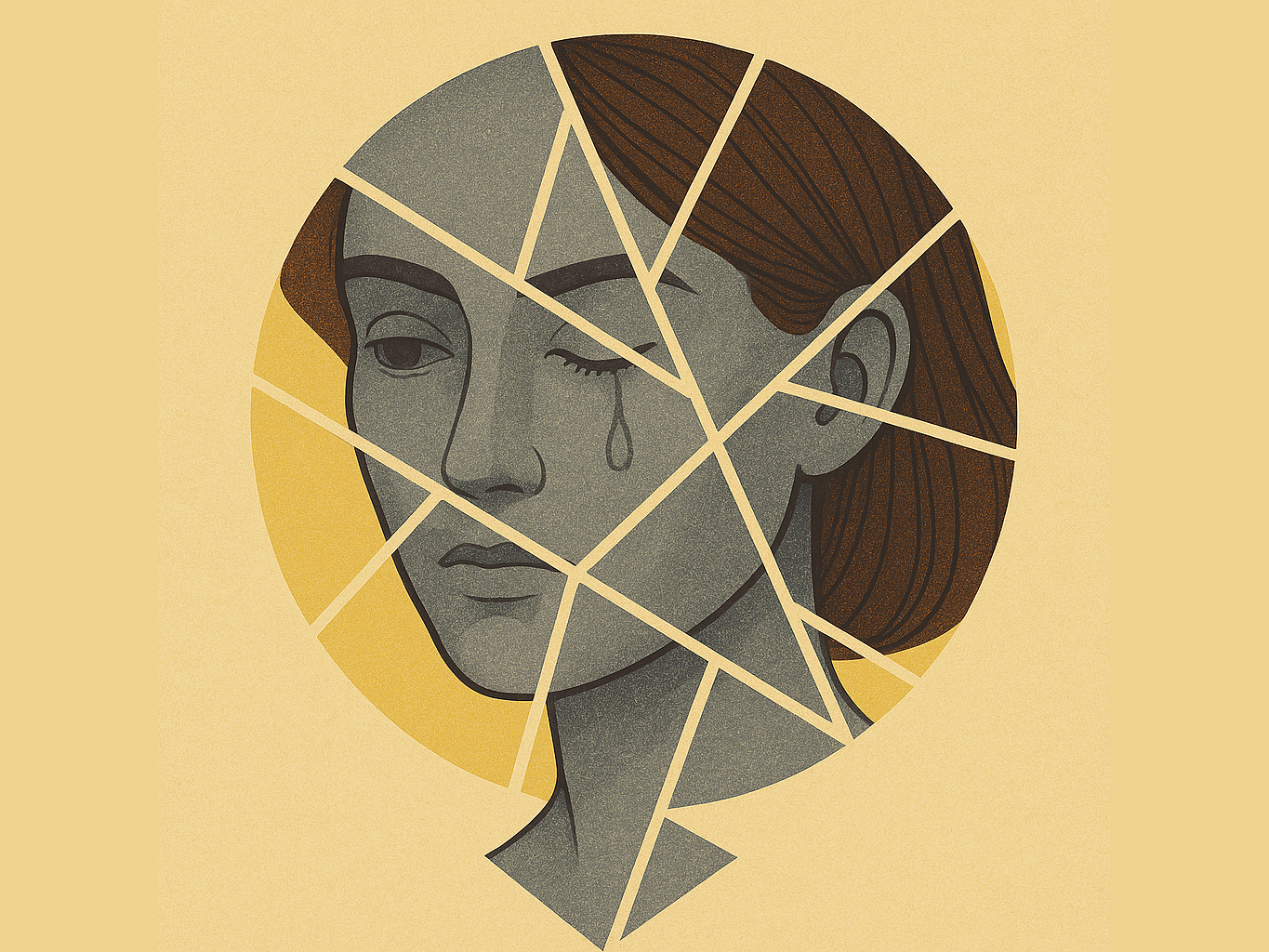PMDS: What is it, who is it affecting, why is it happening?
Low mood, irritability, self-doubt? PMDS affects up to 8% of all menstruating women and can put a strain on everyday life, relationships and mental health. Find out what lies behind the diagnosis, how it differs from PMS and how you can take the first steps to get help.

What causes PMDS
Research assumes that PMDS is caused by hypersensitivity to natural hormone fluctuations (especially oestrogen and progesterone) and their effect on messenger substances such as serotonin in the brain, making PMDS a neurobiologically caused disease. Although the hormone levels themselves are completely normal, the brain reacts differently to them in PMDS [4].

PMDS: An officially recognized diagnosis
PMDS is now officially recognized as a diagnosis - both in the DSM-5 (2013), the Diagnostic and Statistical Manual of Mental Disorders, mainly used in the USA [5] and in the ICD-11 (2022), the International Classification of Diseases of the WHO - worldwide standard [6].
How do you know if you might have PMDS? [5]
You must have at least five symptoms, including at least one that affects your mood, for example:
- Severe mood swings
- Irritability or tantrums
- Sadness or hopelessness
- Severe anxiety or tension
and one or more of the other symptoms to make a total of 5 symptoms:
- Little or no interest in things you usually like to do
- Concentration problems or the feeling of constantly being beside yourself
- Extreme tiredness or no energy at all
- Cravings or significantly altered eating behavior
- Sleeping too much or too little
- The feeling of being completely overwhelmed or losing control
- Physical complaints such as tense breasts, muscle or joint pain, uncomfortable bloating or weight gain

When do PMDS symptoms occur?
The symptoms usually occur in the last week before the period - sometimes they even start two weeks before. They typically subside a few days after the onset of bleeding and are barely present, if at all, in the week after the period [5].

How much do the symptoms affect you in everyday life?
The PMDS symptoms must have a noticeable impact on your life - be it at work, in relationships, in your free time or in everyday tasks [5]. It is also important that other possible causes are ruled out: The symptoms must not be better explained by other conditions such as depression or anxiety disorder [5].
How PMDS affects your life
PMDS doesn't just affect how you feel subjectively - it can turn your whole life upside down. At work, PMDS often leads to lower productivity and more sick days [8]. In relationships, it can lead to arguments, misunderstandings and emotional distance, which can quickly turn PMDS into a stress test for partnerships [9]. Self-perception also changes: many sufferers experience themselves as a completely different person in the second half of the cycle - a phenomenon often described as the "Dr. Jekyll & Ms. Hyde" effect [10]. PMDS is also closely associated with an increased risk of depression, anxiety disorders and even suicidal tendencies [11].
PMDS diagnosis
For an official diagnosis, you should keep a symptom diary - for at least two complete cycles [7,10]. If you are wondering whether your PMS might be PMDS: Here you will find the link to a downloadable cycle diary from the groundbreaking work PMDS as a challenge by Dr. phil. Dipl.-Psych.Almut Dorn, Dr. med. Anneliese Schwenkhagen and Univ.-Prof. Dr. med.Anke Rohde. With this diary you can systematically document your symptoms. Keep the symptom diary for at least two months and present it to your treating gynecologist at your next appointment - she has the necessary expertise to determine whether it is PMDS or not. In future, you can also conveniently document your symptoms in the CAONA app - digitally, securely and available at any time.
Short & sweet - what you can do at PMDS
Document your symptoms: Track your symptoms for at least two menstrual cycles, preferably using a symptom diary or a specialized app. This will give you solid information for your consultation with your doctor.
Seek professional support: Make sure you speak to a gynecologist who is familiar with PMDS. Bring your diary with you and address PMDS directly.
Eat a balanced and nutritious diet: focus on healthy foods and plant-based foods. Avoid highly processed foods, too much sugar, alcohol and smoking.
Exercise regularly: sports such as yoga, aerobics, Pilates or swimming have been proven to help combat PMDS symptoms. Just 20 minutes, three times a week, can bring noticeable improvements.
Pay attention to your stress levels: relaxation techniques, meditation, yoga and mindfulness have been proven to reduce stress and improve emotional balance.
Inform yourself and learn to recognize the positive aspects of your cycle. Knowledge helps you to deal better with PMDS. A holistic view of your symptoms - i.e. not only noticing the negative but also the positive changes that happen in your body - strengthens your self-confidence in dealing with your cycle.
Get emotional support: Whether in a self-help group, with a therapist or in conversation with friends - talking is an important step towards healing. At this point, we recommend the self-help group of the PMDS Hilfe Verein. Here you can talk to other PMDS sufferers every other Tuesday free of charge and without obligation.
Be loving and patient with yourself: PMDS is not a weakness, your body simply needs support. 🌱✨
You now have an initial overview of what PMDS means and what you should look out for. In the next part, you'll find out what ways there are to treat PMDS specifically. If you would like to read more about hormonal health, you may also be interested in our blog post on endometriosis .
Sources
- Dennerstein, L., Lehert, P., & Heinemann, K. (2012). Epidemiology of premenstrual symptoms and disorders. Menopause international, 18(2), 48-51. https://doi.org/10.1258/mi.2012.012013
- Lanza di Scalea, T., & Pearlstein, T. (2019). Premenstrual Dysphoric Disorder (Premenstrual Dysphoric Disorder). Medical Clinics of North America, 103(4), 613-628. https://doi.org/10.1016/j.mcna.2019.02.007
- Reilly, T. J., Patel, S., Unachukwu, I. C., Knox, C.-L., Wilson, C. A., Craig, M. C., Schmalenberger, K. M., Eisenlohr-Moul, T. A., & Cullen, A. E. (2024). The prevalence of premenstrual dysphoric disorder: Systematic review and meta-analysis. Journal of Affective Disorders, 349, 534-540. https://doi.org/10.1016/j.jad.2024.01.066
- Yonkers, K. A., & Simoni, M. K. (2018). Premenstrual disorders. American Journal of Obstetrics & Gynecology, 218(1), 68-74. https://doi.org/10.1016/j.ajog.2017.05.045
- American Psychiatric Association, 2013. DSM-5 diagnostic classification. In: Diagnostic and Statistical Manual of Mental Disorders. https://doi.org/10.1176/appi
- Reed, G. M., First, M. B., Kogan, C. S., Hyman, S. E., Gureje, O., Gaebel, W., Maj, M., Stein, D. J., Maercker, A., Tyrer, P., Claudino, A., Garralda, E., Salvador-Carulla, L., Ray, R., Saunders, J. B., Dua, T., Poznyak, V., Medina-Mora, M. E., Pike, K. M., Ayuso-Mateos, J. L., Kanba, S., Keeley, J. W., Khoury, B., Krasnov, V. N., Kulygina, M., Lovell, A. M., de Jesus Mari, J., Maruta, T., Matsumoto, C., Rebello, T. J., Roberts, M. C., Robles, R., Sharan, P., Zhao, M., Jablensky, A., Udomratn, P., Rahimi-Movaghar, A., Rydelius, P. A., Bährer-Kohler, S., Watts, A. D., & Saxena, S. (2019). Innovations and changes in the ICD-11 classification of mental, behavioral, and neurodevelopmental disorders. World Psychiatry, 18(1), 3-19. https://doi.org/10.1002/wps.20611
- Endicott, J., Nee, J. & Harrison, W. Daily Record of Severity of Problems (DRSP): reliability and validity*.Arch Womens Ment Health* 9, 41-49 (2006). https://doi.org/10.1007/s00737-005-0103-y
- Heinemann, L. A., Minh, T. D., Filonenko, A., & Uhl-Hochgräber, K. (2010). Exploratory evaluation of the impact of severe premenstrual disorders on absenteeism and productivity at work. Women's health issues : official publication of the Jacobs Institute of Women's Health, 20(1), 58-65. https://doi.org/10.1016/j.whi.2009.09.005
- Ussher, J. M., & Perz, J. (2017). Evaluating the relative effectiveness of cognitive behavioral therapy (CBT) for couples with premenstrual disorders (PMDs) compared with single CBT and a waitlist control: a randomized controlled trial. PLOS ONE, 12(4), e0175068. https://doi.org/10.1371/journal.pone.0175068
- Dorn, B., Schwenkhagen, A., & Rohde, A. (2023). PMDS as a challenge: Premenstrual dysphoric disorder as the most severe form of PMS (2nd ed.). Kohlhammer.
- Chan, J.-H., Lo, C., Hsu, C.-D., Chiu, C.-C., Huang, M.-C., Liao, S.-C., Chen, I.-M., Chen, W.-Y., Chen, H.-C., & Kuo, P.-H. (2021). Premenstrual dysphoric symptoms and lifetime suicidal experience in patients with mood disorders. General Hospital Psychiatry, 71, 82-87. https://doi.org/10.1016/j.genhosppsych.2021.04.009
- Trezza, A., & Krabbe, J. P. (2022). A vicious cycle: Using nutrition to combat the behavioral impact of premenstrual syndrome and premenstrual dysphoric disorder. Nutritional Foundations, 1, 1-12.

.jpg)


